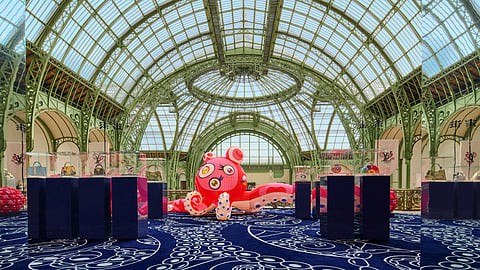Louis Vuitton and Takashi Murakami Reunite at Art Basel Paris with a Monumental Artycapucines Installation
A Landmark Moment in Contemporary Art and Fashion
At this year’s Art Basel Paris, Louis Vuitton celebrates both artistic heritage and innovation through a spectacular collaboration with Japanese contemporary artist Takashi Murakami. The Maison unveils the Artycapucines VII – Louis Vuitton × Takashi Murakami collection, marking nearly twenty years since Murakami first reimagined the House’s Monogram canvas and forever altered the relationship between fashion and art.
Presented on the Balcon d’Honneur at the Grand Palais, the installation is a centerpiece of Art Basel Paris 2025 and stands as one of the fair’s most anticipated presentations. Murakami’s immersive exhibition transforms the venue into a surreal dreamscape that blurs the line between fantasy and craftsmanship, reinforcing Louis Vuitton’s enduring connection to contemporary creation.
The Octopus That Took Over Paris
At the heart of the installation rises an eight-meter-tall octopus sculpture, inspired by traditional Chinese lanterns. Its sprawling tentacles, draped across the exhibition space, weave through a custom carpet designed with matching motifs, creating a complete sensory experience. The creature’s luminescent head features Murakami’s iconic Superflat Jellyfish Eyes pattern, a recurring symbol in his oeuvre since 2001.
This motif, rooted in the artist’s childhood fear of being watched, is reinterpreted with his signature playful tone. Another key reference, the Kraken, recalls his celebrated 2017 exhibition The Octopus Eats Its Own Leg. Together, these themes speak to Murakami’s ability to transform darker psychological symbols into exuberant expressions of curiosity and wonder.
Inside the Tentacles: The Artycapucines VII Collection
Within the octopus’s sweeping form, Louis Vuitton showcases 11 exclusive Artycapucines creations, each meticulously crafted in dialogue with Murakami’s emblematic universe. Beloved characters such as Mr. DOB, Superflat Panda, and Smiling Flowers appear alongside new inspirations, forming an ecosystem of color and imagination.
Three of Murakami’s Plush Balls, spherical works first conceived in 1995, serve as focal points of the installation. The Multicolor Plush Ball (2008) highlights his kaleidoscopic flower motif, while two new works created specifically for Art Basel Paris — the Cherry Blossom Plush Ball (2025) and the Plum Plush Ball (2025) — reinterpret these playful forms through a lens of renewal and rebirth.
The bags themselves extend this artistic language. The Capubloom and Capucines East West Rainbow appear beside the Cherry Blossom Plush Ball, while the Capucines BB Golden Garden, Capusplit BB, and Capucines Mini Autograph form a trio of intricate craftsmanship. A Panda Clutch, adorned with strass, nods to Murakami’s enduring fascination with kawaii culture.
Elsewhere, the Capucines Mini Tentacle and Capucines MM Eye echo the central octopus, adorned with miniature tentacles and Jellyfish Eyes. The Capucines XXL Camo and Capucines East West Dragon draw inspiration from Murakami’s monumental works TIME (2009) and Dragon in Clouds Indigo Blue (2010). The Capucines Mini Mushroom, constructed from approximately 100 hand-embroidered 3D-printed mushrooms, captures the essence of Murakami’s whimsical forest world.
A Testament to Craftsmanship and Collaboration
The Artycapucines series has long stood as a symbol of Louis Vuitton’s dedication to artistic collaboration, each edition inviting a visionary artist to reinterpret the House’s Capucines bag through their creative lens. Murakami’s contribution pushes this dialogue further by blending advanced techniques such as 3D printing with the Maison’s legendary savoir-faire in leatherwork.
This renewed partnership also celebrates Louis Vuitton’s historical connection to art, dating back to Gaston-Louis Vuitton, who in the early 20th century commissioned artists to design window displays and decorative objects. Since 1988, collaborations with artists such as Sol LeWitt, James Rosenquist, Richard Prince, César, and Yayoi Kusama have expanded that legacy, culminating in the Fondation Louis Vuitton, Frank Gehry’s architectural masterpiece in Paris.
The Continuing Legacy of Takashi Murakami
Born in Tokyo in 1960, Takashi Murakami has become one of the most influential figures in global contemporary art. His Superflat theory, a visual approach that merges traditional Japanese painting with anime, manga, and pop culture, redefined the boundaries between fine art and commercial design. His works, characterized by recurring motifs such as smiling flowers, eyes, and mushrooms, appear in the collections of major institutions including the Museum of Modern Art (New York), the Centre Pompidou (Paris), and the Guggenheim Museum (Bilbao).
Murakami’s partnership with Louis Vuitton began in 2003, when he became the first artist invited to reinterpret the Monogram canvas. His Monogram Multicolore, Cherry Blossom, and Monogramouflage designs became cultural touchstones, blending the worlds of art and luxury fashion. That relationship continues to evolve, most recently through the 2025 re-edition of the Louis Vuitton × Murakami collection, reaffirming his enduring influence on both contemporary art and the Maison’s creative heritage.
Where Art and Imagination Converge
The Artycapucines VII – Louis Vuitton × Takashi Murakami presentation at Art Basel Paris 2025 represents more than a collaboration; it is a convergence of imagination, legacy, and innovation. Beneath the tentacled grandeur of Murakami’s octopus, visitors are invited to step into a universe where craftsmanship becomes art and art becomes an act of joyful storytelling.
For Louis Vuitton, the installation is a reminder that luxury has always been about more than beauty or status. It is about dialogue, discovery, and the pursuit of creativity that transcends time.
Inspired by what you read?
Get more stories like this—plus exclusive guides and resident recommendations—delivered to your inbox. Subscribe to our exclusive newsletter
Resident may include affiliate links or sponsored content in our features. These partnerships support our publication and allow us to continue sharing stories and recommendations with our readers.

